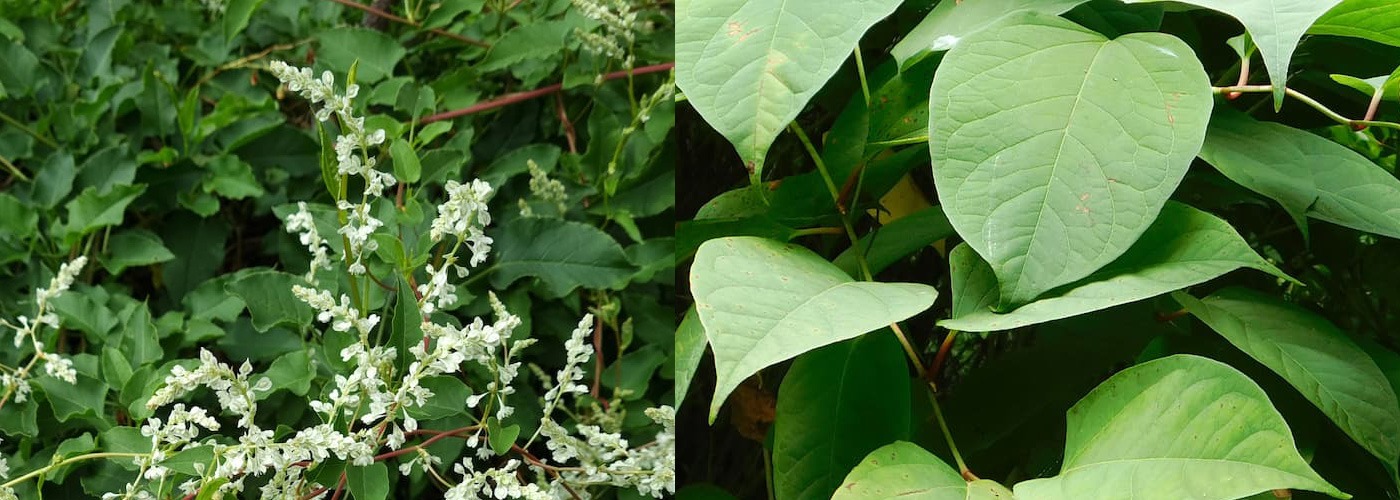Understanding the Similarities Between Japanese Knotweed and Russian Vine
Japanese knotweed and Russian vine are two invasive plant species that can often be confused due to their appearance and aggressive growth habits. Both plants are native to Asia and were introduced to other regions as ornamental plants, but they have since become problematic due to their capacity to spread rapidly and dominate landscapes.
Biologically, Japanese knotweed and Russian vine are very similar, which is why they were originally thought to both be part of the same Fallopia family. Japanese Knotweed has recently been reclassified as Reynoutria Japonica and is no longer labelled Falloopia Japonica This connection is evident in several of their shared characteristics. For instance, both plants have the ability to grow quickly, with Russian vine also known as ‘Mile-a-Minute’ due to its rapid growth rate.
The visual similarities between the two species include their small, white flowers that bloom in late summer, particularly in August and September. However, despite these similarities, there are distinct differences that help differentiate the two. For example, Russian vine leaves are pointed and nearly triangular, whereas Japanese knotweed leaves are heart-shaped.
One of the most notable differences is the way Russian vine behaves: it tends to tangle itself around other plants or structures, while Japanese knotweed grows in dense clumps without relying on support. This climbing habit of Russian vine can sometimes make it even more invasive, as it can overwhelm and smother other vegetation.
Both plants can cause significant problems if not managed properly. Their aggressive nature means they can quickly overtake gardens, damage building foundations, and disrupt native ecosystems. As a result, it is crucial to accurately identify these species to implement effective control measures. Understanding the similarities and differences between Japanese knotweed and Russian vine is the first step in managing their impact on our environment.
How to Tell Japanese Knotweed from Russian Vine Apart
The invasive species Japanese knotweed and Russian vine may share some similarities but are distinct plants that can be identified by their unique features. Accurate identification is essential for effective management and control. Here’s how to tell them apart:
Key identification features of Japanese Knotweed
Japanese knotweed (Reynoutria Japonica) is characterised by several key features:
- Leaves: Its leaves are shovel or heart-shaped with a flat base and pointed tip, usually around 15cm in length.
- Stems: The stems are bamboo-like, hollow, and have distinct raised nodes, giving them a jointed appearance.
- Flowers: Small, creamy white flowers appear in late summer and early autumn, forming in clusters.
- Growth habit: The plant grows in dense clumps and can reach heights of up to 2-3 metres.
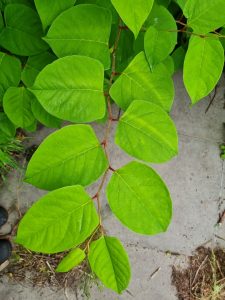
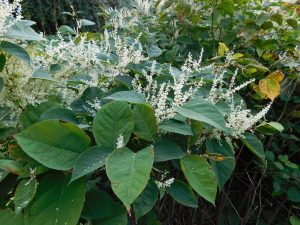

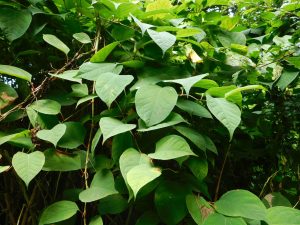
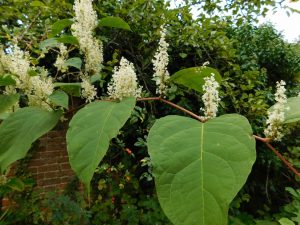
Distinguishing characteristics of Russian Vine
Russian vine, also known as mile-a-minute (Fallopia baldschuanica), has its own distinguishing characteristics:
- Leaves: The leaves are more triangular or heart-shaped with a base that can be rounded or slightly cordate, often with a pointed tip.
- Stems: Unlike Japanese knotweed, Russian vine is a climbing plant that uses other structures or vegetation for support.
- Flowers: It produces panicles of small, white flowers similar to those of Japanese knotweed but blooms slightly earlier in the year.
- Growth habit: As its nickname suggests, Russian vine grows rapidly and can quickly cover large areas.

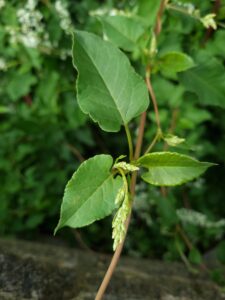
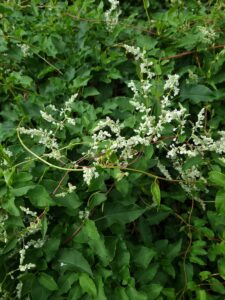
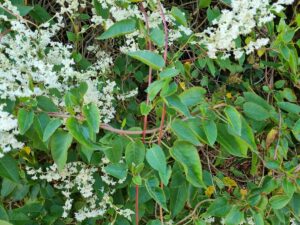
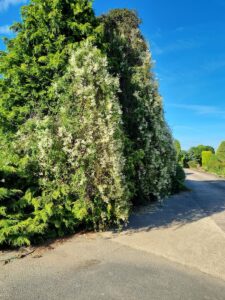
Practical tips and visual guides for differentiation
To differentiate between Japanese knotweed and Russian vine, consider the following practical tips and use visual guides:
- Leaf shape and arrangement: Compare the leaf shapes carefully, looking for the flat base of Japanese knotweed leaves versus the more triangular shape of Russian vine leaves.
- Growth pattern: Observe whether the plant is growing in dense clumps (Japanese knotweed) or climbing and entangling (Russian vine).
- Flowering time: Notice the flowering time since Japanese knotweed flowers a bit later in the season.
- Consult visual guides: Use online resources or identification guides that provide detailed images and descriptions of both plants.
Importance of early detection and seeking professional assistance in identification
Early detection of either plant is crucial to preventing their spread. If you suspect the presence of Japanese knotweed or Russian vine on your property:
- Act quickly: The sooner these plants are identified, the easier they are to control.
- Seek professional assistance: Professionals can provide accurate identification and recommend appropriate management strategies.
- Do not attempt removal without advice: Improper removal can lead to further spread, especially since both plants can propagate from small fragments.
Accurately differentiating between Japanese knotweed and Russian vine is essential for property owners, gardeners, and environmental managers. While there are helpful visual markers for identification, consulting with specialists ensures that the invasive plants are correctly identified and managed, preventing ecological damage and potential legal issues.
Conclusion
Recap of the Distinctions between Japanese Knotweed and Russian Vine
As we have explored, Japanese knotweed and Russian vine, while similar in some aspects, possess distinctive features that allow for their identification. Japanese knotweed has heart-shaped leaves, bamboo-like stems, and grows in dense clumps, while Russian vine has more triangular leaves, is a climbing plant, and is known for its rapid growth that can quickly envelop structures and other plants.
Emphasis on Proactive Management and Education in Addressing Invasive Plant Species
The control and management of invasive species like Japanese knotweed and Russian vine require a proactive approach. Education about these plants and their impact is vital for landscape professionals, gardeners, and the general public. Understanding how to identify and manage these species can prevent the costly damage they inflict on property and the environment. Regulatory bodies, conservation groups, and community initiatives play a significant role in spreading awareness and providing guidance on managing these invasive plants effectively.
Final Thoughts on the Importance of Preserving Native Ecosystems and Biodiversity through Responsible Stewardship
The spread of invasive species like Japanese knotweed and Russian vine is more than a nuisance—it’s a threat to native ecosystems and biodiversity. These plants can outcompete native flora, disrupt habitats for fauna, and alter the ecological balance. As responsible stewards of the environment, it is our duty to maintain the health and diversity of our ecosystems. By identifying invasive species early, employing professional assistance for their management, and educating ourselves and others, we can help preserve the integrity of our natural landscapes for future generations.
Resources
The Invasive Species Specialist Group (ISSG) a global network of scientific and policy experts on invasive species – Facebook group https://www.facebook.com/IUCNSSCISSG/
UK Centre for Ecology & Hydrology https://www.ceh.ac.uk/our-science/case-studies/japanese-knotweed-and-property-market
Delta Simons Protecting people and planet – https://www.deltasimons.com/news/but-is-it-japanese-knotweed/
Royal Horticulture Society https://www.rhs.org.uk/plants/7143/fallopia-baldschuanica/details
Gardeners World https://www.gardenersworld.com/how-to/grow-plants/how-to-grow-russian-vine/
The Postcode Areas We Serve
Gloucester and Swindon
Birmingham and the Midlands
Bristol and the South West
Cardiff and South Wales
